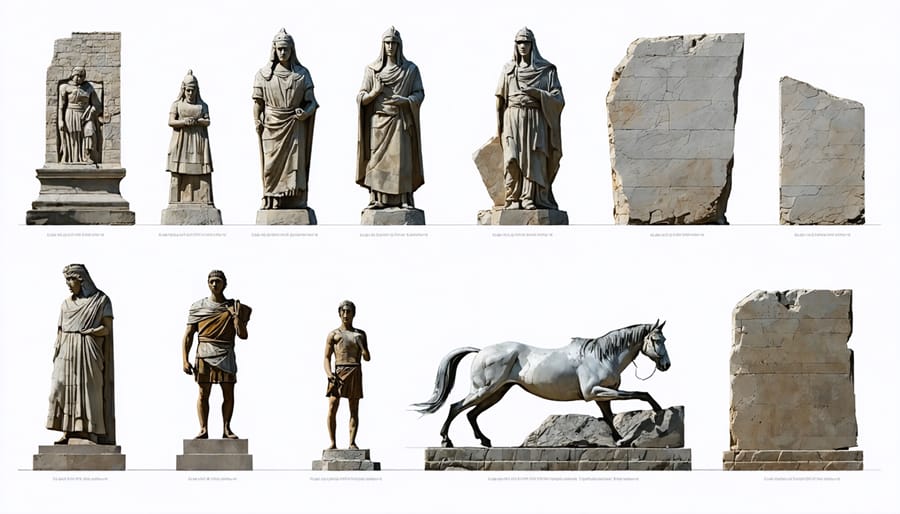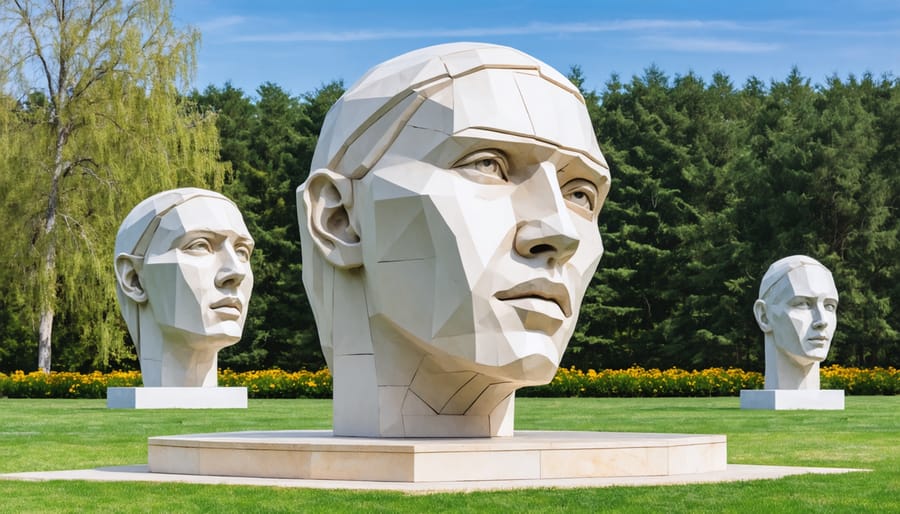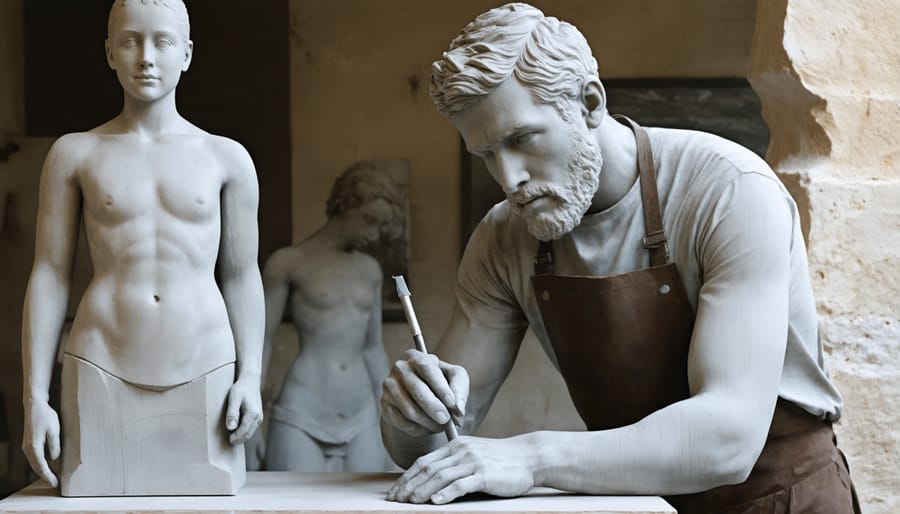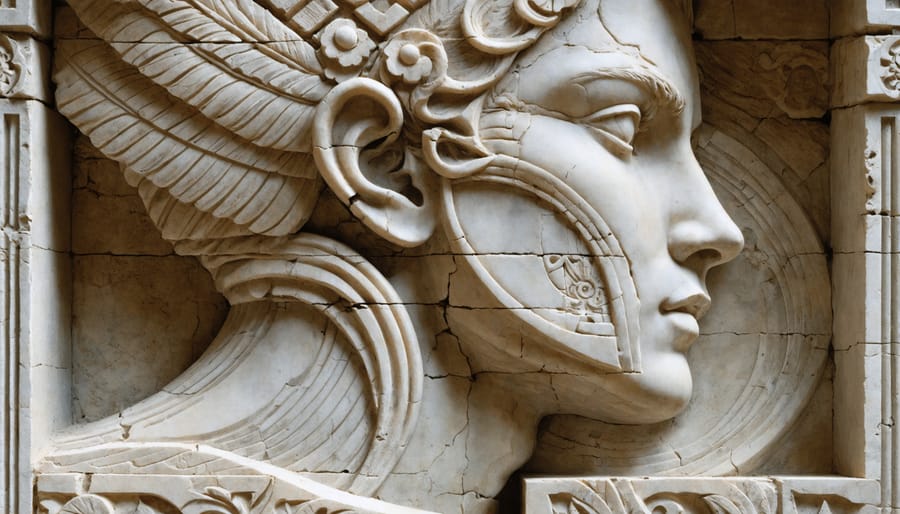In the hands of contemporary stone sculptors, ancient limestone and marble transform into striking commentaries on modern life. Today’s artists push the boundaries of this age-old medium, combining traditional carving techniques with digital technology and innovative tools to create works that challenge our perception of stone’s limitations. From Lauren Bon’s massive environmental installations to Isamu Noguchi’s influential legacy, modern stone sculptors are reimagining what’s possible with this elemental material.
While classical stone carving focused on representational figures and decorative elements, contemporary artists explore abstract forms, social themes, and environmental statements. They employ diamond-tipped power tools, CNC machines, and even artificial intelligence to plan and execute increasingly complex designs. Yet these technological advances serve to enhance rather than replace the intimate connection between artist and stone that has defined this art form for millennia.
As urban spaces evolve and public art gains prominence, stone sculpture has found new relevance in creating meaningful dialogue between built environments and natural materials. These artists don’t just shape stone – they challenge our assumptions about permanence, nature, and human intervention in the physical world.
The Evolution of Stone Sculpture: From Ancient Times to Modern Day
The journey of stone sculpture spans millennia, beginning with our ancestors who created earliest stone artworks using rudimentary tools. From these humble beginnings, civilizations developed increasingly sophisticated techniques, with the ancient Greek marble traditions setting standards that continue to influence artists today.
The Renaissance period marked a crucial evolution in stone sculpture, with masters like Michelangelo revolutionizing the approach to working with marble. Their innovative techniques and understanding of human anatomy elevated stone sculpture from craft to high art, establishing principles that remain relevant for contemporary artists.
The 20th century brought dramatic changes to stone sculpture. Artists began breaking away from classical representations, experimenting with abstract forms and challenging traditional perspectives. The introduction of power tools and advanced cutting technologies opened new possibilities for stone manipulation, allowing artists to achieve previously impossible forms and textures.
Today’s stone sculptors blend time-honored techniques with modern technology. Digital design software helps artists visualize complex forms before touching stone, while diamond-tipped tools and CNC machines enable precise execution. However, many contemporary artists still maintain a deep connection to traditional hand-carving methods, creating a fascinating dialogue between ancient and modern approaches.
Modern stone sculpture has evolved beyond purely decorative or commemorative purposes. Contemporary artists use stone to address current social issues, explore environmental concerns, and push the boundaries of what’s possible with this ancient medium. The durability of stone continues to appeal to artists seeking to create lasting statements in an increasingly digital world.
This evolution from ancient to modern times demonstrates how stone sculpture remains a vital art form, constantly adapting while maintaining its connection to human history and cultural expression.

Leading Contemporary Stone Sculptors
Emily Young: The Last Stone Carver of Britain
Emily Young, often hailed as “Britain’s greatest living stone sculptor,” has carved an extraordinary legacy through her masterful transformation of ancient stone into contemporary art. Working primarily with discarded pieces from quarries, Young’s practice embodies both artistic excellence and environmental consciousness.
Her signature style involves leaving portions of stone in their natural state while carefully carving ethereal faces and abstract forms into other sections. This distinctive approach creates a powerful dialogue between the raw material’s geological history and human intervention, speaking to our relationship with the natural world.
Young’s environmental advocacy is as prominent as her artistic work. Through her “Financial Times Climate Change Challenge” installations and other public works, she draws attention to ecological issues, particularly the impact of quarrying on landscapes. Her studio in Italy, where she works with locally sourced stone, serves as a model for sustainable artistic practice.
Notable works include the massive heads at St. Paul’s Cathedral and her “Solar Disk” series, which explores themes of light, time, and human consciousness. Young’s pieces can be found in prestigious collections worldwide, from London’s Victoria and Albert Museum to private gardens in California.
Her influence extends beyond sculpture, inspiring a new generation of artists to consider environmental responsibility alongside artistic vision. Through her work, Young demonstrates how contemporary stone sculpture can serve as both a medium for expression and a platform for environmental discourse.

Isamu Noguchi’s Lasting Legacy
Isamu Noguchi’s influence on modern stone sculpture transcends generations, reshaping how artists approach the medium. His revolutionary integration of traditional Japanese aesthetics with modernist principles created a unique visual language that continues to inspire contemporary sculptors worldwide.
Noguchi’s genius lay in his ability to reveal the inherent beauty of stone while incorporating architectural elements and environmental consciousness. His gardens and public spaces, such as the UNESCO Gardens in Paris and the Sunken Garden for Chase Manhattan Bank Plaza in New York, demonstrated how stone sculpture could transform urban environments into contemplative spaces.
The artist’s experimental approach to material handling, particularly his technique of combining rough and polished surfaces within single works, has become a foundational practice for modern stone sculptors. His emphasis on the relationship between sculpture and space influenced how artists today consider site-specificity and environmental context in their work.
Noguchi’s cross-cultural perspective and interdisciplinary approach opened new possibilities for stone sculpture. His work bridged the gap between fine art, design, and landscape architecture, encouraging contemporary artists to explore similar boundary-crossing practices. This holistic vision continues to shape public art installations, landscape design, and architectural integration of stone sculpture.
Modern sculptors frequently cite Noguchi’s philosophy of “sculpture of spaces” as a guiding principle, carrying forward his legacy of creating work that exists in harmony with its environment rather than as an isolated object.
Rising Stars in Contemporary Stone Sculpture
A new generation of stone sculptors is revolutionizing the ancient craft through innovative techniques and bold artistic visions. Among these emerging talents, Japanese artist Sakura Tanaka stands out for her delicate fusion of traditional granite carving with contemporary minimalist design. Her series “Whispers in Stone” showcases how modern artists can achieve seemingly impossible levels of transparency in solid rock.
Brazilian sculptor Rafael Santos has gained recognition for his sustainable approach, working exclusively with salvaged stone from demolished buildings. His urban-inspired pieces challenge conventional notions of permanence while addressing environmental concerns in modern sculpture.
Chinese artist Li Wei Ming combines advanced 3D modeling technology with traditional hand-carving techniques to create mathematically precise geometric forms that seem to defy gravity. His work demonstrates how digital tools can enhance rather than replace traditional craftsmanship.
American artist Maya Harrison is breaking new ground with her interactive stone installations that incorporate light and sound elements. By embedding fiber optics within carefully carved limestone, she creates pieces that respond to viewer presence, bringing an unexpected dynamic quality to stone art.
These rising stars, along with others like Kenya’s James Mweu and Italy’s Sofia Bianchi, represent a diverse global movement that’s redefining stone sculpture for the 21st century. Their work proves that even in our digital age, the ancient medium of stone continues to offer endless possibilities for artistic innovation.
Modern Techniques and Tools

Traditional vs. Modern Tools
While classical stone sculpting techniques relied heavily on manual tools like chisels, hammers, and rasps, today’s stone sculptors blend traditional methods with cutting-edge technology. Modern artists now have access to pneumatic hammers, diamond-tipped power tools, and even computer-controlled machinery that can rough out basic forms with unprecedented precision.
Traditional hand tools remain essential for fine detail work and maintaining tactile connection with the stone. The basic hammer and chisel set, points, pitching tools, and claw chisels continue to be fundamental instruments in any sculptor’s toolkit. However, these are now complemented by electric grinders, diamond wire saws, and ultrasonic devices that can achieve effects impossible with manual tools alone.
Digital scanning and 3D modeling software allow artists to preview and plan their sculptures virtually before touching the stone. CNC (Computer Numerical Control) machines can rough out complex forms that would take weeks to accomplish by hand, though master sculptors emphasize that these tools serve only as aids rather than replacements for artistic vision and skilled handwork.
Modern safety equipment has also evolved significantly, with better dust collection systems, protective gear, and ventilation solutions making the craft safer and more sustainable for artists. This combination of traditional wisdom and contemporary innovation has opened new possibilities in stone sculpture while preserving the essence of this ancient art form.
Digital Integration in Stone Sculpture
Digital technology has revolutionized the way modern stone sculptors approach their craft, combining ancient techniques with cutting-edge innovation. Computer-aided design (CAD) software allows artists to visualize and plan complex sculptures before touching the stone, reducing material waste and enabling more precise execution of their vision.
3D scanning technology helps artists create exact digital replicas of existing sculptures for restoration work or reproduction. These scans can also be manipulated digitally to explore different variations of a design. CNC (Computer Numerical Control) machines, guided by these digital designs, can rough out basic forms in stone, saving artists countless hours of initial labor while maintaining accuracy.
Robot-assisted carving systems have become valuable tools in modern studios, particularly for large-scale projects. These robots can work continuously on repetitive tasks, following programmed patterns while leaving the fine details and artistic finishing touches to the sculptor’s skilled hands.
Digital projection mapping helps artists visualize their work in different contexts and scales before committing to final cuts. Additionally, augmented reality (AR) applications allow sculptors to preview how their pieces will look in specific locations or interact with different lighting conditions.
Despite these technological advances, most contemporary stone sculptors maintain a balance between digital tools and traditional hand-carving techniques, recognizing that the soul of stone sculpture still lies in the direct connection between artist and material.
The Future of Stone Sculpture
As we look toward the future, stone sculpture continues to evolve at the intersection of tradition and innovation. The evolution of stone artistry has entered an exciting new phase, where digital technology and ancient techniques merge to create unprecedented possibilities.
3D scanning and CNC machining are revolutionizing the preliminary stages of stone sculpture, allowing artists to prototype and plan their works with unprecedented precision. However, rather than replacing traditional hand-carving, these technologies are becoming valuable tools that complement artists’ manual skills.
Environmental consciousness is increasingly influencing stone sculpture, with artists incorporating themes of sustainability and natural preservation into their work. Many sculptors are choosing to work with reclaimed stone or developing techniques to minimize waste material. Some are even creating installations that address climate change and environmental degradation directly through their stone artwork.
The rise of urban renewal projects has created new opportunities for stone sculptors to contribute to public spaces. Cities worldwide are commissioning large-scale stone installations that serve both aesthetic and functional purposes, such as integrated seating areas or water features. These projects demonstrate how contemporary stone sculpture can enhance community spaces while maintaining its artistic integrity.
Mixed-media approaches are gaining prominence, with artists combining stone with materials like glass, metal, or light elements. This fusion creates dynamic works that challenge traditional perceptions of stone sculpture while honoring the medium’s timeless qualities.
Educational institutions are adapting their curricula to embrace these emerging trends, ensuring the next generation of stone sculptors is versed in both traditional techniques and modern technologies. This balanced approach is crucial for preserving the craft while pushing its boundaries into new territories.
The future of stone sculpture appears to be one of synthesis – where ancient wisdom meets contemporary innovation, creating works that resonate with modern audiences while maintaining the profound connection to Earth’s natural materials that has always defined this art form.
Modern stone sculpture continues to evolve and thrive in the contemporary art world, seamlessly blending ancient techniques with innovative approaches. Today’s artists are pushing boundaries by incorporating new technologies like 3D modeling and CNC machinery while maintaining the intimate connection to stone that has defined this art form for millennia.
The field has become increasingly diverse, with artists from various cultural backgrounds bringing fresh perspectives to stone carving. Environmental consciousness has emerged as a significant theme, with many sculptors choosing sustainable practices and exploring themes of nature and conservation in their work. This ecological awareness has led to creative reuse of materials and more efficient quarrying practices.
Digital tools and traditional hand-carving now exist in harmony, allowing artists to achieve previously impossible forms while preserving the tactile essence of stonework. Contemporary stone sculptors are also breaking conventional boundaries by combining stone with other materials like metal, glass, and light elements, creating dynamic installations that challenge our perceptions of this ancient medium.
The market for stone sculpture has expanded beyond traditional gallery spaces, with public art installations and architectural integration becoming increasingly important venues. As we look to the future, stone sculpture continues to demonstrate its relevance in modern art, proving that this timeless medium remains a powerful vehicle for artistic expression in the digital age.










